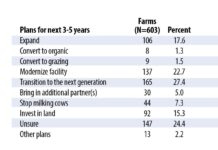Holmes Co., Alpine Cheese water quality trading project is successful
The idea set forth to Holmes SWCD and others was relatively straightforward, yet innovative. The Alpine Cheese Company in Holmes County needed to expand its production to meet the market demands of Jarlsberg Cheese, of which they are the sole manufacturer in the U.S.
In order to do that, they needed upgrades to their wastewater treatment system, which is regulated by an Ohio EPA discharge permit. Long story short, the plant upgrade to get the phosphorus level discharge to the 1 ppm/P required by Ohio EPA from the 3 ppm/P the system upgrade could comfortably meet was going to be super expensive.
Solution
Alpine Cheese Company would rather put that money into the community to pay farmers to keep phosphorous from getting into the stream in the first place through a water quality trading program instead of expensive equipment. It was win-win — Alpine Cheese needs the dairy farmers to produce milk and the dairy farmers need a market. Both have to be environmentally responsible.
Richard Moore of The Ohio State University OARDC and his staff spearheaded the meetings and discussions surrounding this project. Ohio EPA, USDA agencies, Holmes County commissioners, then State Representative Bob Gibbs, Farm Bureau, SWCD staff and representatives of the Alpine Cheese Company all sat at the table to hammer out the details.
I’m not going to pretend that the process was easy, because basically the plan was created from scratch and there was a sharp learning curve. But there was a sincere effort on everyone’s part to make sure this program would provide real results, and wasn’t a numbers game on paper.
Outline
Here’s the plan in a nutshell: Alpine Cheese provided funding to Holmes SWCD to pass along to farmers to install conservation practices on farms, plus administrative overhead for SWCD staff to do the necessary contact, planning and design practices to USDA-Natural Resources Conservation Service standards.
The Ohio State University received funding to write the trading plan and conduct intensive stream quality monitoring. An EPA/Ohio Department of Natural Resources-approved pollution load reduction spreadsheet was utilized to determine how much phosphorus reduction could be attributed to a conservation practice on a case by case basis.
Yes, each feedlot was measured, each cow was counted and distances from streams factored in an attempt to get accurate pollution reduction numbers from the model.
Ratio
One of the benefits of a water quality trading program is that the ratios required from the nonpoint source is 3:1, according to Ohio trading rules. That means the point source gets one credit for every three pounds of nutrient removed. Because of this ratio, the public is certain that more nutrients are getting removed than the point source is being credited.
Now in year four (it is based on the Alpine Cheese permit renewal of January 2007) of this program, we are seeing the results. The cost-share money to fund conservation practices was largely committed by mid-2008.
The SWCD worked with 25 farmers in the Sugar Creek watershed to install 98 practices. These are small, Amish dairy farms that in general installed milk house waste tanks, made feedlot improvements and established heavy use pads.
The amount of phosphorus reduced by each practice generated credits and determined how much cost-share they could be paid. The Ohio EPA requirement for the program was 5,500 credits (16,500 pounds of phosphorus reduction) by the end of year five. We now have 5,581 credits at the end of year four and project 7,156 credits by the end of year five.
Conservation practices generally have a life span of 15 to 20 years, so the investment made today will potentially be paying dividends 20 years into the future.
The “stream team” at The Ohio State University OARDC has copious amounts of stream data to suggest the amount of phosphorous in the Sugar Creek watershed is decreasing. Obviously the upgrade to the Alpine Cheese plant has had an impact, but the data is broader than just where Alpine discharges.
Model
And, a third-party biological assessment shows the Middle Fork Sugar Creek, where Alpine is discharging, is rated excellent. This program is serving as a model for others in Ohio and around the U.S.
My colleague (and husband, incidentally) Duane Wood of Wayne SWCD wrote in this column back in July 2010 about the possibility of expanding water quality trading to the Muskingum Watershed and the joint board of SWCDs formed to pursue that possibility.
Water quality trading may have critics, but in our experience it is an effective way to pay farmers to get conservation on the ground, and allow manufacturing a cost-effective means of operating and adding more jobs (Alpine Cheese added several jobs with its expansion).
With state and local funding being cut, water quality trading may be an alternate way to fund conservation practices that make a positive impact on water quality.
(Michelle Wood is the program administrator for the Holmes Soil and Water Conservation District. She is a graduate of Mount Union College with a degree in communications, and has been involved in natural resources and agriculture throughout her career.)












